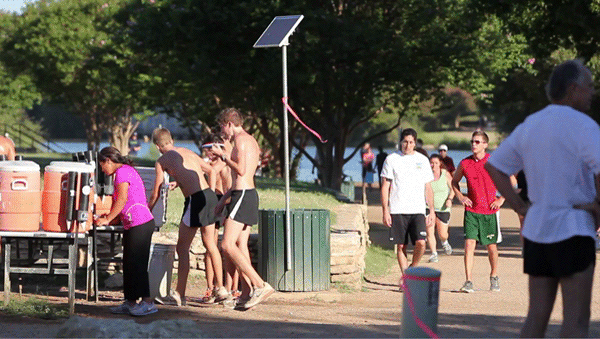Dougstory
It was January 2, 1992 and I was riding downhill on Austin’s South First Street along with my racing coach, Mark Edwards. I was twenty-one and had taken a break from Baylor to start a cycling team.
As we approached an intersection, a van abruptly turned right in front of us. Mark yelled a warning, but it was too late: I plowed into the van head first and was not wearing a helmet.
The next day, the accident was front-page news in the Austin American Statesman. I; Doug Richardson, was in an induced coma for eight days and spent six months in rehab for a traumatic brain injury (TBI), followed by years of therapy. I lost my memories prior to the accident, and my IQ dropped to the level of a high school junior.
What I didn’t know at that bleak low point is how the phenomenon of neuroplasticity would carve new paths in my brain, my life—and in the tech world. Before the accident, I had no talent or interest in graphics. Twelve years later in 2006, I had filed my first patent for a new video technology. Not only that, I went on to successfully sue 6 tech giants like Samsung and Motorola to enforce the 7 issued patents I currently have.
My neurologist, Dr. David Morledge, wrote an article in which he explained that the brain “has the ability to compensate and adapt to injury, thanks to the phenomenon of neuroplasticity.” I asked him if this is what happened to me, he responded, “I would say that your ‘re-wiring’ after your TBI allowed you to develop a newfound talent that otherwise you would not have had.”
It turns out that the TBI that robbed me of so much also left me a gift: a significant boost in my visual processing, spatial perception, and visual-motor integration. That’s the power of neuroplasticity, the ability of our damaged neural networks to find new pathways.
I want people to know my story, because neuroplasticity is available in less dramatic ways to everyone, at every age.
That new skill did not come to me—I had to find it which required accepting and pushing through many mistakes and failures along the way. Two years after the accident I returned to college, this time in Austin. Although I had never had interest in visual art or technology, something drew me to a photography class. Digital SLRs were not yet common; I bought a 1976 Canon AE-1, for $150, and developed my black-and-white shots in the school lab. In 1997, with a degree in photography, I became a full-time sports photographer, covering sports in and around Austin.
That was the beginning of this newfound talent. In late 2004, I started thinking about how to combine still images and animation in a small file size. One afternoon, I was driving to Frisco, Texas listening to Nine Inch Nails when out of the blue, all the pieces came together. I could see how to create such an animation and invented Cinegif technology which is now commonly known as “cinemagraph”: a photograph in which one element is moving, such as the dog crossing the street, while the cars remain still.
I began pitching what I then called “EmailFilm” to local companies for use in their email campaigns. The local Jaguar/Land Rover dealership was my first client, who told me their click-through rates went through the ceiling with my new tech. I shot cinemagraphs for businesses ranging from real estate , the automotive industry to health care. By 2011 I had started a new company, Cinegif.com, with three employees and a new CEO.
Not everyone saw this as a clever idea. According to Forbes Magazine, “Around 97% of all patents never recoup the cost of filing them.” My therapist warned that it was unlikely I would ever see any royalties and she was right on one sense.
In 2013, I noticed Samsung was using my technology on its mobile phones and wanted to pursue legal action. The Cinegif CEO fought me on that, insisting it was useless to fight such a huge company and that the legal fees would kills us. Since Cinegif had possession of my patents at that point, he had the final word.
By early 2016, we could no longer compete with the major users like Samsung who had expanded my technology worldwide. Cinegif was shut down.
The silver lining: I reacquired ownership of my patents, and in 2017 I hired a law firm and filed suit against Samsung. What followed legally is a tangled story with many highs and lows, but within a year we were in mediation. At the first meeting, all five attorneys and Samsung reps went around the table introducing themselves. I was the last person and just said, “My name is Doug Richardson and I invented this . . . stuff.” Not my classiest moment. But we settled with Samsung at this mediation in July 2018.
Over the next four years, I filed and settled with four other major companies who had used my technology, including Motorola, Pond5 and Shutterstock.
What does my story mean for uninjured people? I want them to know it can be their story, too. The neuroplasticity superpower belongs to every brain—even in old age. According to the Washington Post, “New research dispels the belief that plasticity, the brain’s capacity to respond to change, diminishes in the adult and aging brain.” Our brain’s ability to heal and shift resources to new areas, develop new pathways, new skills, new ways of thinking, never leaves us.
I can tell you from experience that the rewiring isn’t easy. You must hold a belief in yourself and a belief that your brain will get you there in the end. You cannot succeed without making mistakes, and in my experience, the more mistakes, the better your result.
Your brain is more powerful and agile than you think. Try. Make those mistakes. Change your life. I did.
Cinemagraph TM Flixel.
